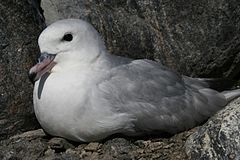Fulmarus
| Fulmarus[1] | |||
| Stephens, 1826[2] | |||
Photo © Samuel Blanc, CC BY-SA 3.0 Przedstawiciel rodzaju – fulmar południowy (F. glacialoides) | |||
| Systematyka | |||
| Domena | |||
|---|---|---|---|
| Królestwo | |||
| Typ | |||
| Podtyp | |||
| Gromada | |||
| Podgromada | |||
| Infragromada | |||
| Rząd | |||
| Rodzina | |||
| Rodzaj | Fulmarus | ||
| Typ nomenklatoryczny | |||
Procellaria glacialis Linnaeus, 1761 | |||
| Synonimy | |||
| Gatunki | |||
| |||
Fulmarus – rodzaj ptaka z rodziny burzykowatych (Procellariidae).
Zasięg występowania
Rodzaj obejmuje gatunki oceaniczne występujące na wybrzeżach, wyspach i otwartych wodach Oceanu Arktycznego, Atlantyckiego, Spokojnego i Południowego[7].
Morfologia
Długość ciała 45–50 cm, rozpiętość skrzydeł 102–120 cm; masa ciała samic 535–1020 g, samców 689–1180 g[8].
Systematyka
Etymologia
- Fulmarus: stnor. nazwa Fúlmár (fúll „cuchnący”; már „mewa”) dla fulmara zwyczajnego[9].
- Halohippus: gr. ἁλς hals, ἁλος halos „morze”; ἱππος hippos „koń”[9]. Gatunek typowy: Procellaria glacialis Linnaeus, 1761.
- Rhantistes: gr. ῥαντης rhantēs „tryskacz”, od ῥαινω rhainō „tryskać”[9]. Gatunek typowy: Procellaria glacialis Linnaeus, 1761.
- Wagellus: przestarzała, kornwalijska nazwa Wagel dla wydrzyka ostrosternego lub mewy siodłatej[9]. Gatunek typowy: Procellaria glacialis Linnaeus, 1761.
- Priocella: zbitka wyrazowa nazw rodzajów: Prion Lesson, 1829 (petrelek) i Procellaria Linnaeus, 1758 (burzyk)[9]. Gatunek typowy: Priocella garnotii Hombron & Jacquinot, 1844 (= Procellaria glacialoides A. Smith, 1840).
Podział systematyczny
Do rodzaju należą następujące gatunki[10]:
- Fulmarus glacialis (Linnaeus, 1761) – fulmar zwyczajny
- Fulmarus glacialoides (A. Smith, 1840) – fulmar południowy
Przypisy
- ↑ Fulmarus, [w:] Integrated Taxonomic Information System [online] (ang.).
- ↑ J.F. Stephens: Fulmarus. Fulmar. W: G. Shaw: General zoology, or Systematic natural history. T. 13: Aves. Cz. 1. London: Printed for G. Kearsley, 1826, s. 233. (ang.).
- ↑ G.J. Billberg: Synopsis Faunae Scandinaviae. T. 1. Cz. 2: Aves. Holmiae: Ex officina typogr. Caroli Deleen, 1828, s. 192. (łac.).
- ↑ J.J. Kaup: Skizzirte Entwickelungs-Geschichte und natürliches System der europäischen Thierwelt: Erster Theil welcher die Vogelsäugethiere und Vögel nebst Andeutung der Entstehung der letzteren aus Amphibien enthält. Darmstadt: In commission bei Carl Wilhelm Leske, 1829, s. 105. (niem.).
- ↑ G.R. Gray: A list of the genera of birds: with their synonyma an indication of the typical species of each genus. London: R. and J.E. Taylor, 1840, s. 78. (ang.).
- ↑ J.B. Hombron & H. Jacquinot. Remarques sur quelques points de l’anatomie et de la physiologie des Procellarides, et essai d’une nouvelle classification de ces oiseaux. „Comptes Rendus Hebdomadaires des Séances de l’Académie des Sciences”. 18, s. 357, 1844. (fr.).
- ↑ F. Gill, D. Donsker & P. Rasmussen (red.): IOC World Bird List (v11.2). [dostęp 2021-07-22]. (ang.).
- ↑ C. Carboneras: Family Procellariidae (Petrels and Shearwaters). W: J. del Hoyo, A. Elliott & J. Sargatal (red.): Handbook of the Birds of the World. Cz. 1: Ostrich to Ducks. Barcelona: Lynx Edicions, 1992, s. 235–236. ISBN 84-87334-10-5. (ang.).
- ↑ a b c d e Etymologia za: James A. Jobling: The Key to Scientific Names. [w:] Birds of the World [on-line]. Cornell Lab of Ornithology, Ithaca, NY, USA, 2021. (ang.).
- ↑ Systematyka i nazwy polskie za: P. Mielczarek & M. Kuziemko: Rodzina: Procellariidae Leach, 1820 - burzykowate - Petrels & Shearwaters (Wersja: 2021-04-05). [w:] Kompletna lista ptaków świata [on-line]. Instytut Nauk o Środowisku Uniwersytetu Jagiellońskiego. [dostęp 2021-07-22].
Media użyte na tej stronie
Autor: (of code) -xfi-, Licencja: CC BY-SA 3.0
The Wikispecies logo created by Zephram Stark based on a concept design by Jeremykemp.


